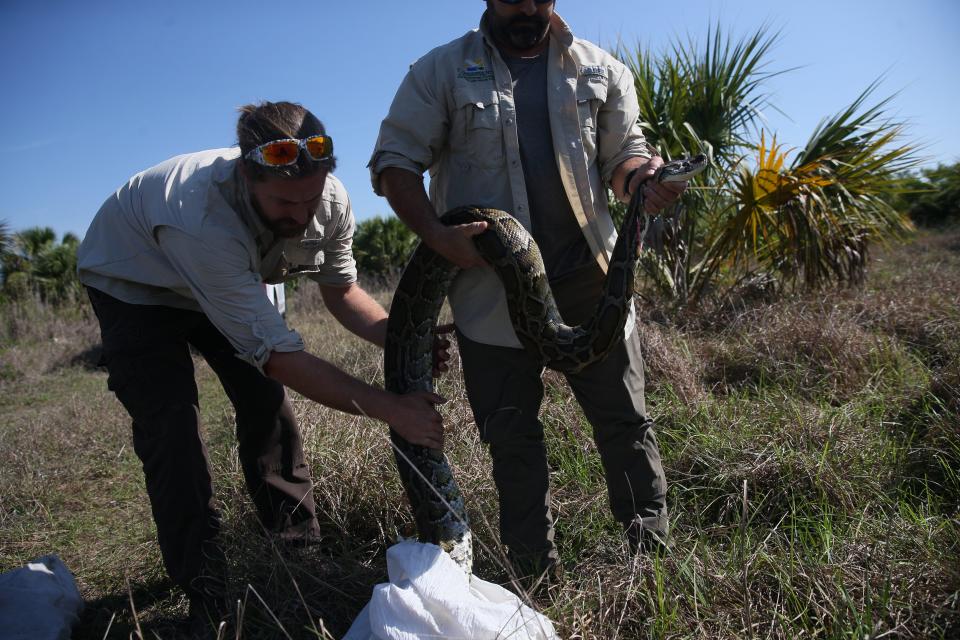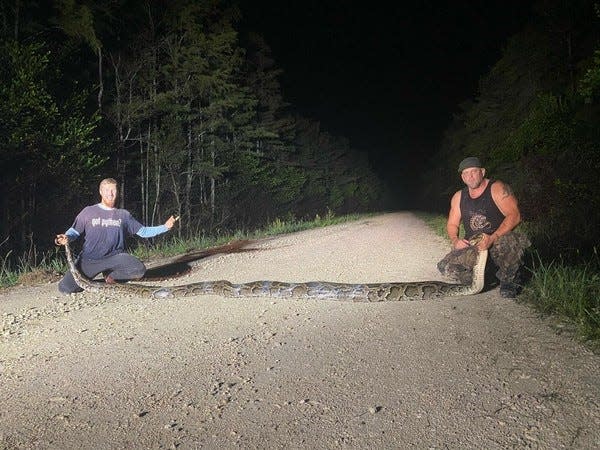What do we know about Florida pythons after a decade of research? A lot - and it's unsettling
For the last decade, scientists with the Conservancy of Southwest Florida and other groups have hauled out more than 1,000 snakes from 160 square miles in south Florida – more than 30,000 pounds of snake bearing some 10,000 eggs.
Over that time, they’ve learned a lot about the beefy invasive predators, though some questions remain. Here are 10 takeaways from the past 10 years.
They get big – really big
Last year, Conservancy of Southwest Florida scientists pulled out a nearly 18-foot-long, 215-pound female with 122 developing eggs from Collier County’s Picayune Strand.
Python prey? Almost anything with a pulse
From mice to deer, with alligators and pet cats in between, these snakes will tackle most prey that moves. According to the U.S. Geological Survey, which recently published a comprehensive review of invasive python research in Florida, some Everglades-area mammals have all but vanished. It cites a 2012 showing that raccoons had dropped 99.3%, opossums 98.9%, and bobcats 87.5 percent since 1997, while “marsh rabbits, cottontail rabbits and foxes effectively disappeared.”

Amazing python photos!: 28 of the best Burmese python photos from our archives
Caught!: Record-breaking 18-foot Burmese python pulled from Collier County wilderness
But Burmese pythons don’t eat people
Not in the wilds of Florida, at least. As far as science knows, no Burmese python has ever killed a human here and even in captivity, deaths from the snakes are super rare. According to the journal Live Science, “Between 1978 and 2009, large constricting snakes killed 16 humans in the United States; at least seven of these deaths were attributed to captive Burmese pythons.”
Babies, babies: They’re very fertile
Though that record-breaking snake above had more than 100 eggs still in her body, the highest recorded number of eggs actually deposited into a nest is 96. Of those, 83 appeared to have hatched, though on average, they lay 49 eggs.
Water is no problem
The species is considered semi-aquatic and can stay submerged up to half an hour. In 2019, a fishing guide discovered a big one out for a swim in Naples Bay.
Thriving here, but vulnerable in their home range
Though Burmese pythons' natural range is huge – from northeastern India through southern China, Southeast Asia and the Malay Peninsula (though not the Philippines) – they’re considered threatened. The International Union of Conservation Naturalists has placed them on its red list, which documents species at risk of extinction.

How many Burmese pythons are there in Florida?
Jane Q. Public to scientist: Can you tell me, ballpark even, what’s the python population in Florida?
Scientist: Nope. Not gonna do it.
It’s not that the scientists are being stubborn; it’s the scientists being scientists – thank goodness – and not making wild guesses. Because at this point, that’s all such a number would be. There’s no way to count them with any accuracy. The most definite a statement you’re going to get is this, from the USGS: “Tens of thousands of invasive Burmese pythons are estimated to be present in the Everglades.”
Our best python videos: Pythons caught on video include record catch and hunting adventure
Python Challenge 2023: Fish and Wildlife Commission sets Burmese python hunt for 10 days in August
Some native critters bite back
Not in sufficient numbers to make a dent in their populations, but Florida animals have been documented preying on Burmese pythons. Bobcats, alligators, cottonmouths and indigo snakes have all attacked and eaten the snakes and their eggs.
They have a great sense of direction
When scientists took Burmese pythons from their Everglades homes and released them miles away, the snakes quickly headed back to where they started, according to the USGS. The online article “Invasive Burmese Pythons Are Good Navigators and Can Find Their Way Home” reports that when researchers hauled six tagged snakes between 13 and 22 miles away, ” The relocated snakes moved faster and straighter than snakes that were not relocated, demonstrating that Burmese pythons have navigational map and compass senses.”
Coming soon to the woods near you?
Though historically, the pythons have been centered in the Everglades, they’re expanding their range, says Conservancy of Southwest Florida wildlife biologist Ian Bartoszek, who wouldn’t be surprised if they had long since set up shop around Alva and LaBelle. Though the pythons have been turning up for years around Miami and in the Keys, they don’t yet appear to be breeding there (yet).
This article originally appeared on Naples Daily News: Pythons in Florida: 10 takeaways from a decade of research

